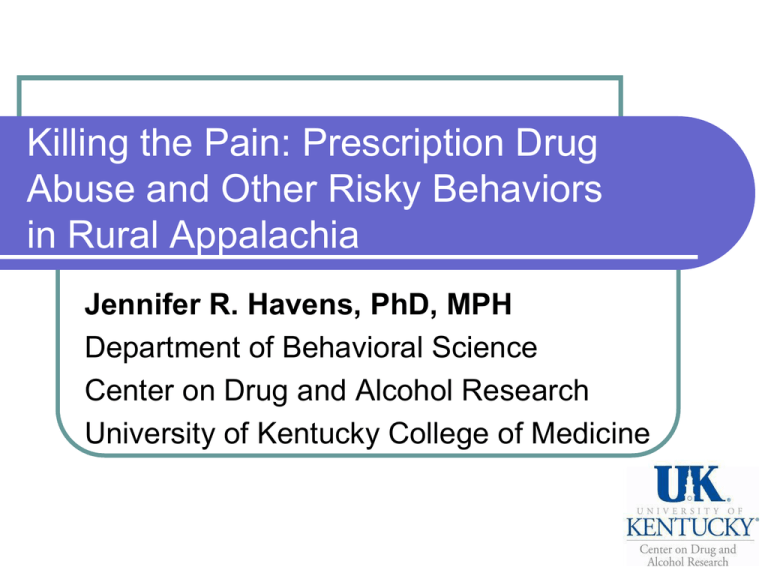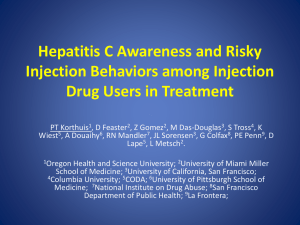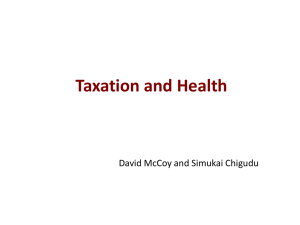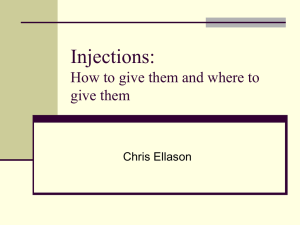
Killing the Pain: Prescription Drug
Abuse and Other Risky Behaviors
in Rural Appalachia
Jennifer R. Havens, PhD, MPH
Department of Behavioral Science
Center on Drug and Alcohol Research
University of Kentucky College of Medicine
Annual numbers (in millions) of new nonmedical
users of pain relievers aged 12 and older
Source: National Household Survey on Drug Abuse 1970-2000
Past Year Illicit Drug Dependence or Abuse
Source: National Survey on Drug Use and Health 2002
Percent increase in number of treatment
admissions for narcotic painkillers: 1997 – 2002
Source: Treatment Episode Data Set 1997 - 2002
Background
Rural Substance Abuse
Differing trends – rates of prescription
drug opiate use and methamphetamine
higher than urban areas
(Havens et al., Am J Drug Alc Abuse, 2007; Havens et
al., Am J Drug Alc Abuse, 2009)
Differing drugs of abuse may be due to
lack of availability of drugs such as
heroin in rural areas
Injection Drug Use among Rural
Drug Users
Previous research: IDU rare among
rural drug users in Appalachian Kentucky
(Leukefeld et al., Substance Use and Misuse, 1997)
Recent research suggested a much
higher prevalence of IDU among
Appalachian drug users (>40%)
(Havens et al., Drug and Alcohol Dependence, 2007).
IDU among Appalachian Drug Users
Majority of rural IDUs reported injecting
OxyContin® and other prescription drugs
NOT designed for injection
Fewer than 10% had ever injected heroin
and/or cocaine
Self-reported hepatitis C infection
significantly higher among the IDUs
versus non-IDUs (p<0.001)
(Havens et al., Drug and Alcohol Dependence, 2007)
Social Networks and HIV Risk
among Rural Drug Users
Overall goal of the study is to determine
the prevalence and incidence of HIV,
hepatitis C and herpes simplex-2 virus
as well as to examine both individual and
social network-related risk factors for HIV
and other infectious diseases among
rural drug users
Specific Aims
To determine prevalence and incidence
of HIV, hepatitis C (HCV) and herpes
simplex-2 virus (HSV-2) among rural
IDUs and non-IDUs
Characterize risk for HIV and other
infectious diseases among rural injection
and non-injection drug users in the
context of both individual-level and
network-level risk
Participants
500 rural out-of-treatment injection and
non-injection drug users recruited and
followed at 6-, 12-, and 18-months postbaseline
Storefront location in rural town
Participants recruited via Respondent
Driven Sampling (RDS)
24- and 30-month follow-up ongoing
Eligibility Criteria
Age 18+
English-speaking
IDU (initial seeds)
Use of at least 1 of the following drugs in prior
6 mo:
Rx Opiates (illicit use)
Cocaine
Heroin
Methamphetamine
Outcomes
HIV, HCV, HSV-2 prevalence and
incidence (i.e., seroconversion)
HIV risk behaviors
unprotected sex
sharing syringes and other injection-related
paraphernalia
Data Collection Procedures
Interviewer-administered questionnaire
Computer-assisted personal interview
(CAPI) via tablet PC
Serologic testing (with pre- and post-test
counseling)
HIV (with confirmatory testing)
HCV
HSV-2
Baseline Data Participant Characteristics N=503
Male
n
%
286
56.7
Age, median (IQR)
31 (26 ,38)
Caucasian
474
94.2
Employed Full-Time
173
34.4
Lifetime Injection Drug Use
394
78.3
Prevalent HIV
0
0
Prevalent HCV
220
43.7
Prevalent HSV-2
58
11.5
Incident HCV
36
12.7
Incident HSV-2
50
11.2
Baseline Data – Drug Use
Lifetime
Past 30 Days
Alcohol
499
99.2
276
54.9
Methadone (illicit)
476
94.6
306
60.8
Heroin
176
35.0
22
4.4
OxyContin
477
94.8
351
69.8
Oxycodone
482
95.8
364
72.4
Hydrocodone
488
97.0
408
81.3
Benzodiazepines
480
95.5
429
85.3
Methamphetamine
219
43.5
17
3.4
Cocaine
472
93.8
113
22.5
Marijuana
491
97.6
308
61.2
Baseline Data – Age of Onset
Alcohol
Benzodiazepines
Cocaine
Marijuana
Age 14
Hydrocodone
Age 18
Oxycodone
Age 20
OxyContin
Heroin
Methadone
Crack
Age 21
Age 23
IDU
Age 22
Methamphet
amine
Age 24
Drugs Initiated Injection With
(n=394 Lifetime IDUs)
n
%
OxyContin
190
48.2
Other Rx opiates
53
13.4
243
61.7
4
1.0
Cocaine
117
29.7
Heroin
19
4.8
TOTAL ALL Rx opiates
Methamphetamine
Baseline Data – IDU Drugs
(n=394 Lifetime IDUs)
n
%
Rx Opiates
348
88.3
Rx Stimulants
27
6.8
Rx Benzodiazepines
23
5.8
Methamphetamine
39
9.9
Cocaine
271
68.8
Heroin
95
24.1
Speedball (cocaine/OxyContin)
60
15.2
Baseline Data -Sex Risk
n
%
Male Sex Partners, median (IQR)
9 (5, 17.5)
Female Sex Partners, median (IQR)
20 (10, 45)
Sexual Orientation
Heterosexual
459
91.2
Homosexual
9
1.8
Bisexual
34
6.8
Sex Encounters w/o Condom (30 days)
14 (4, 30)
Baseline Data – Drug Risk
n
%
Sharing Syringes (past 6 mo) N=288
92
31.9
Sharing Cottons, Cookers, Water (6 mo)
N=288
137
47.6
Daily Injection N=288
102
35.4
Sharing Straws (6 mo) N=503
407
88.9
Overdose (Lifetime) N=503
146
29.0
Baseline Data – Social Networks
Support Network Members, median (IQR)
Drug Network Members, median (IQR)
2 (1, 3)
4 (2, 9)
Sex Network Members, median (IQR)
2 (1, 5)
Drug Network
by
Drug Network by HCV Status
Results from Ongoing or
Published Studies from SNAP
Transition to Injection
HCV Prevalence
Methadone Use
Overdose
Initiation to Injection
48.2% of participants initiated injection
with OxyContin®
Young and Havens, Addiction, 2012
Initiation to Injection
Young and Havens, Addiction, 2012
Initiation to Injection
Young and Havens, Addiction, 2012
Hepatitis C
Overall prevalence is 44.1% (54.5%
among IDUs)
Incidence is about 10 cases/100 PY
Independent associations with HCV:
Syringe sharing (aOR: 2.04, 95% CI: 1.20, 3.45)
Years IDU (aOR: 1.04, 95% CI: 1.01, 1.07)
Injecting Rx opiates (aOR: 2.37, 95% CI: 1.21, 4.63)
Injecting Cocaine (aOR: 2.24, 95% CI: 1.41, 3.54)
Havens et al., American Journal of Public Health, 2013
Methadone Use
94.6% of cohort report lifetime illicit
methadone use
Methadone NOT diverted from treatment
programs
Factors associated with high frequency
methadone use: older age, less exposure to
drug tx, not having Rx for physical problem, not using
OxyContin concurrently, fewer lifetime arrests and
experiencing recent drug problems
Hall, Leukefeld and Havens, under review, 2013
Overdose
28% experienced 1 or more ODs
58% witnessed 1 or more ODs
Individual factors associated with OD:
ever in drug tx, injection of Rx opiates,
PTSD, ASPD
Network factors associated with OD:
having additional support network
members
Havens et al., Drug and Alcohol Dependence, 2011
Acknowledgements
NIH/NIDA (R01-DA024598)
Dr. Carl Leukefeld (BSC), Dr. Carrie
Oser (Sociology) and Dr. Rick Crosby
(Health Behavior)
Center on Drug and Alcohol Research
Department of Behavioral Science








